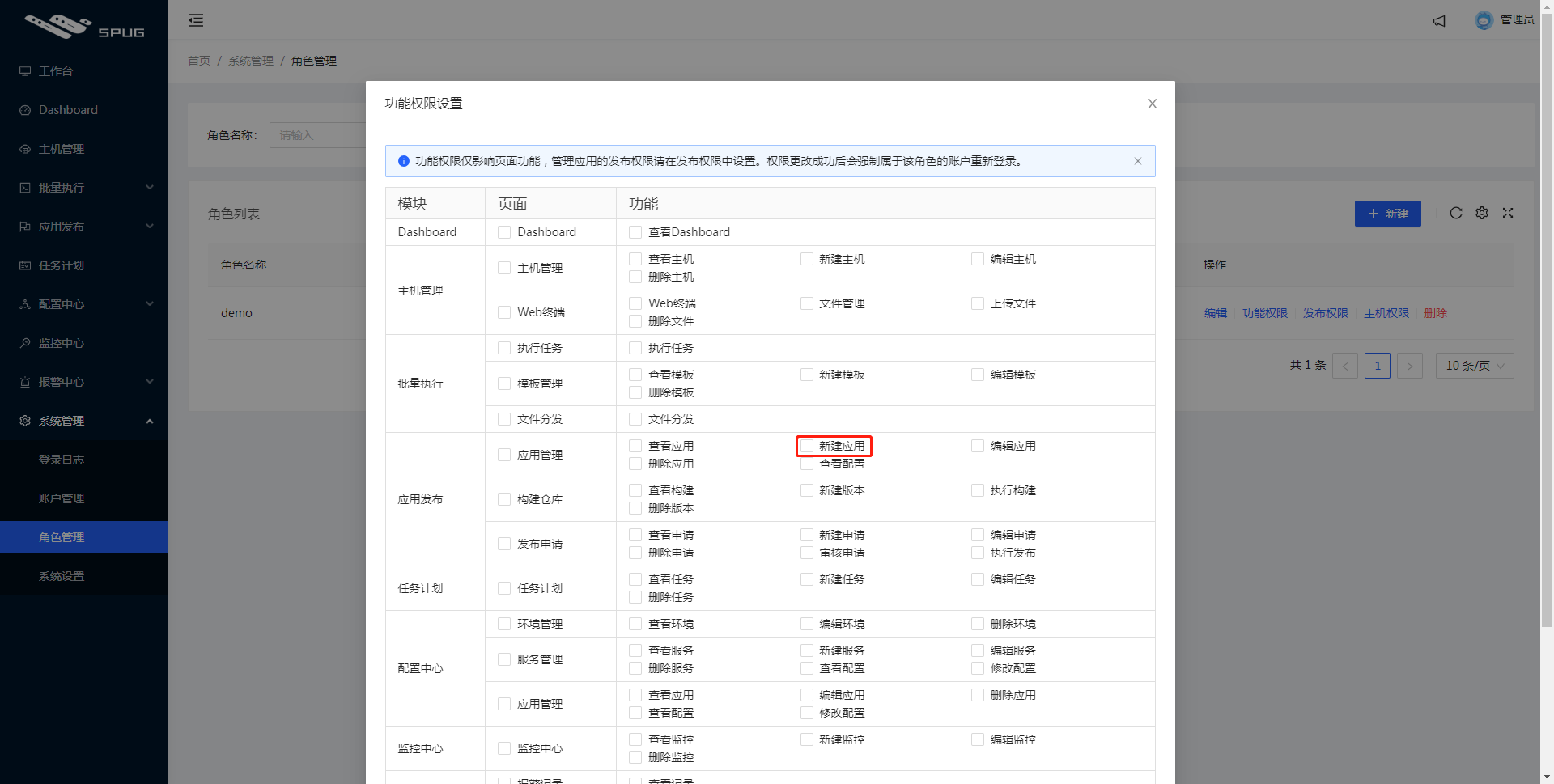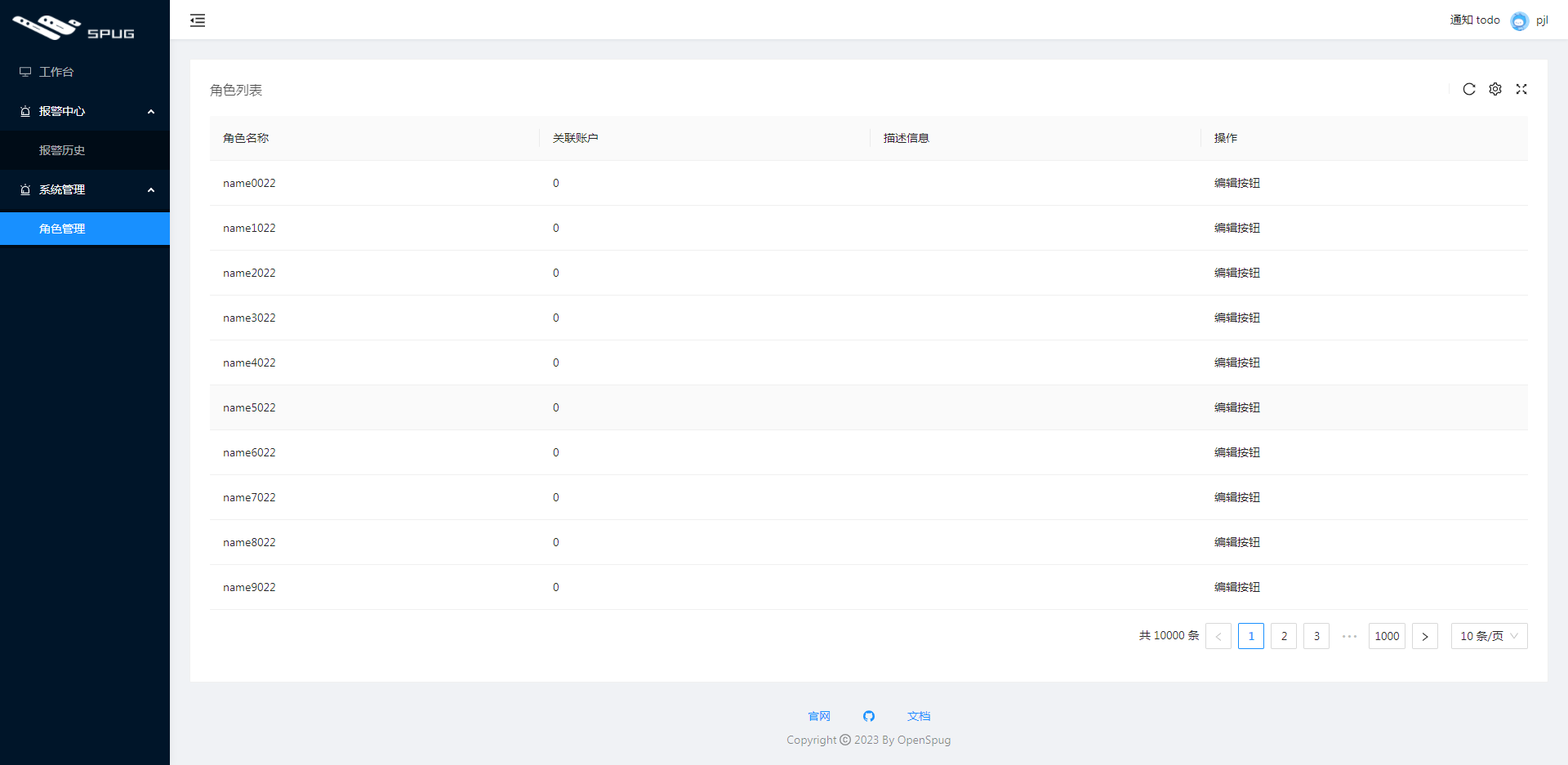- Java锁的逻辑(结合对象头和ObjectMonitor)
- 还在用饼状图?来瞧瞧这些炫酷的百分比可视化新图形(附代码实现)⛵
- 自动注册实体类到EntityFrameworkCore上下文,并适配ABP及ABPVNext
- 基于Sklearn机器学习代码实战
其他章节请看:
react 高效高质量搭建后台系统 系列 。
本系列已近尾声, 权限 是后台系统必不可少的一部分,本篇首先分析 spug 项目中权限的实现,最后在将权限加入到我们的项目中来.
比如我要将 应用发布 模块的 查看 权限分给某用户(例如 pjl ),可以这样操作:
在角色管理中新建一角色(例如 demo ),然后给该角色配置权限:
新建用户( pjl )并赋予其 demo 权限 。
pjl 登录后就只能看到自己有权限的页面和操作:
上述示例中,以 pjl 登录成功后返回如下数据:
{
"data": {
"id": 2,
"access_token": "74b0fe67d09646ee9ca44fc48c6b457a",
"nickname": "pjl",
"is_supper": false,
"has_real_ip": true,
"permissions": [
"deploy.app.view",
"deploy.repository.view"
]
},
"error": ""
}
其中 permissions 表示该用户的权限.
vscode 搜索 deploy.app.view 有两处:
deploy.app.view )就不展示该页面内容。
// spug\src\pages\deploy\app\index.js
export default observer(function () {
return (
<AuthDiv auth="deploy.app.view">
<Breadcrumb>
<Breadcrumb.Item>首页</Breadcrumb.Item>
<Breadcrumb.Item>应用发布</Breadcrumb.Item>
<Breadcrumb.Item>应用管理</Breadcrumb.Item>
</Breadcrumb>
<ComTable/>
</AuthDiv>
);
})
Tip :AuthDiv 用于控制页内组件的权限,里面通过 hasPermission 判断是否有对应的权限,如果没有,该组件内的子元素则不会显示.
export default function AuthDiv(props) {
let disabled = props.disabled === undefined ? false : props.disabled;
if (props.auth && !hasPermission(props.auth)) {
disabled = true;
}
return disabled ? null : <div {...props}>{props.children}</div>
}
// 前端页面的权限判断(仅作为前端功能展示的控制,具体权限控制应在后端实现)
export function hasPermission(strCode) {
const {isSuper, permissions} = Permission;
if (!strCode || isSuper) return true;
for (let or_item of strCode.split('|')) {
if (isSubArray(permissions, or_item.split('&'))) {
return true
}
}
return false
}
auth 指授权,这里定义的是模块和页面的查看权限。其中 deploy.app.view|deploy.repository.view|deploy.request.view 表示只要有其中一个权限,“应用发布”就会展示。
// spug\src\routes.js
{
icon: <FlagOutlined />, title: '应用发布', auth: 'deploy.app.view|deploy.repository.view|deploy.request.view', child: [
{ title: '应用管理', auth: 'deploy.app.view', path: '/deploy/app', component: DeployApp },
{ title: '构建仓库', auth: 'deploy.repository.view', path: '/deploy/repository', component: DeployRepository },
{ title: '发布申请', auth: 'deploy.request.view', path: '/deploy/request', component: DeployRequest },
]
},
现在我们已经知道页面级的权限解决思路:
查看 (spug 中是 xx.xx.view )权限。如果没有 auth 则说明该页面任何人都可以访问
// spug\src\layout\Sider.js
function makeMenu(menu) {
// 仅取出有权限的菜单
if (menu.auth && !hasPermission(menu.auth)) return null;
if (!menu.title) return null;
return menu.child ? _makeSubMenu(menu) : _makeItem(menu)
}
如果直接通过 url 去访问没有权限的页面会如何:
直接 404.
为什么是 404? 因为路由数组(Routes)中只取了有权限的菜单页面.
// spug\src\layout\index.js
<Switch>
{/* 路由数组。里面每项类似这样:<Route exact key={route.path} path='/home' component={HomeComponent}/> */}
{Routes}
{/* 没有匹配则进入 NotFound */}
<Route component={NotFound}/>
</Switch>
Routes 的内容请看路由初始化方法:
// 将 routes 中有权限的路由提取到 Routes 中
function initRoutes(Routes, routes) {
for (let route of routes) {
if (route.component) {
// 如果不需要权限,或有权限则放入 Routes
if (!route.auth || hasPermission(route.auth)) {
Routes.push(<Route exact key={route.path} path={route.path} component={route.component}/>)
}
} else if (route.child) {
initRoutes(Routes, route.child)
}
}
}
新增、删除等页内的权限如何实现的呢?我们把 发布配置 页内的 新建 权限放开,后端权限返回列表中将有: deploy.app.add 。

vscode 只搜索到一处匹配 deploy.app.add .
<TableCard
tKey="da"
...
actions={[
<AuthButton
auth="deploy.app.add"
type="primary"
icon={<PlusOutlined/>}
onClick={() => store.showForm()}>新建</AuthButton>
]}
其中 AuthButton 和上文的 AuthDiv 一样,如果有权限则显示其中内容 。
// spug\src\components\AuthButton.js
export default function AuthButton(props) {
let disabled = props.disabled;
if (props.auth && !hasPermission(props.auth)) {
disabled = true;
}
return disabled ? null : <Button {...props}>{props.children}</Button>
}
于是我们知道页内级的权限解决思路:
功能权限设置 中定义对应操作权限的值,选中后把该值传递给后端 
权限的值在 codes.js 中定义如下:
// codes.js
{
key: 'deploy',
label: '应用发布',
pages: [
{
key: 'app',
label: '应用管理',
perms: [
{ key: 'view', label: '查看应用' },
{ key: 'add', label: '新建应用' },
{ key: 'edit', label: '编辑应用' },
{ key: 'del', label: '删除应用' },
{ key: 'config', label: '查看配置' },
]
},
{
key: 'repository',
label: '构建仓库',
perms: [
{ key: 'view', label: '查看构建' },
{ key: 'add', label: '新建版本' },
]
},
...
]
},
登录后返回权限中还有个字段 is_supper 。数据格式就像这样:
{
"data": {
"id": 1,
"access_token": "6a0cef69a7d64b6f8c755ff341266e76",
"nickname": "管理员",
"is_supper": true,
"has_real_ip": true,
"permissions": [ ]
},
"error": ""
}
is_supper 是 true,permissions 为空数组。猜测 is_supper 的作用有2个:
isSuper )直接返回有权限,无需其他判断。就像这样:
// 前端页面的权限判断(仅作为前端功能展示的控制,具体权限控制应在后端实现)
export function hasPermission(strCode) {
const {isSuper, permissions} = Permission;
if (!strCode || isSuper) return true;
for (let or_item of strCode.split('|')) {
if (isSubArray(permissions, or_item.split('&'))) {
return true
}
}
return false
}
is_supper )是作为最大的权限再做一些页面上的操作。例如这里隐藏该片段:
<Form.Item hidden={store.record.is_supper} label="角色" style={{marginBottom: 0}}>
<Form.Item name="role_ids" style={{display: 'inline-block', width: '80%'}} extra="权限最大化原则,组合多个角色权限。">
<Select mode="multiple" placeholder="请选择">
{roleStore.records.map(item => (
<Select.Option value={item.id} key={item.id}>{item.name}</Select.Option>
))}
</Select>
</Form.Item>
<Form.Item style={{display: 'inline-block', width: '20%', textAlign: 'right'}}>
<Link to="/system/role">新建角色</Link>
</Form.Item>
</Form.Item>
spug 中的权限整体思路:
功能权限设置 弹框)将某些权限(页面级和页内级)赋予某角色,再让某用户属于该角色 permissions 、 is_supper 字段)告诉前端该用户的权限 所以权限这里包含两条线:
需求 :用户没有以下三个权限( 报警联系人 、 报警联系组 、角色管理中的 新增 )。见下图3个红框:

最终效果如下:

在 routes.js 中定义每个菜单(也是路由)的权限:
export default [
// 无需权限
{ icon: <DesktopOutlined />, title: '工作台', path: '/home', component: HomeIndex },
{
icon: <AlertOutlined />, title: '报警中心', auth: 'alarm.alarm.view|alarm.contact.view|alarm.group.view', child: [
{ title: '报警历史', auth: 'alarm.alarm.view', path: '/alarm/alarm', component: AlarmCenter },
{ title: '报警联系人', auth: 'alarm.contact.view', path: '/alarm/contact', component: AlarmCenter },
{ title: '报警联系组', auth: 'alarm.group.view', path: '/alarm/group', component: AlarmCenter },
]
},
{
icon: <AlertOutlined />, title: '系统管理', auth: "system.role.view", child: [
{ title: '角色管理', auth: 'system.role.view', path: '/system/role', component: SystemRole },
]
},
{ path: '/welcome/info', component: WelcomeInfo },
]
Tip :例如 角色管理 页面需要 system.role.view 这个权限。命名任意,因为后端返回的权限是前端发送给的后端.
更新权限判断逻辑。之前统统返回 true:
// 之前
export function hasPermission(strCode) {
return true
}
现在看后端是否返回该权限:
// 前端页面的权限判断(仅作为前端功能展示的控制,具体权限控制应在后端实现)
export function hasPermission(strCode) {
const { isSuper, permissions } = Permission;
if (!strCode || isSuper) return true;
for (let or_item of strCode.split('|')) {
if (isSubArray(permissions, or_item.split('&'))) {
return true
}
}
return false
}
// 数组包含关系判断
export function isSubArray(parent, child) {
for (let item of child) {
if (!parent.includes(item.trim())) {
return false
}
}
return true
}
定义两个组件(AuthButton、AuthDiv),并导出:
import React from 'react';
import { Button } from 'antd';
import { hasPermission } from '@/libs';
export default function AuthButton(props) {
let disabled = props.disabled;
if (props.auth && !hasPermission(props.auth)) {
disabled = true;
}
return disabled ? null : <Button {...props}>{props.children}</Button>
}
import React from 'react';
import { hasPermission } from '@/libs';
export default function AuthDiv(props) {
let disabled = props.disabled === undefined ? false : props.disabled;
if (props.auth && !hasPermission(props.auth)) {
disabled = true;
}
return disabled ? null : <div {...props}>{props.children}</div>
}
// myspug\src\compoments\index.js
import NotFound from './NotFound';
import TableCard from './TableCard';
import AuthButton from './AuthButton'
import AuthDiv from './AuthDiv'
export {
NotFound,
TableCard,
AuthButton,
AuthDiv,
}
例如新建按钮就放入 AuthButton 组件中,而整个角色管理的入口模块就放入 AuthDiv 中.
// mock/index.js
{
"data": {
"id": 2,
"access_token": "74b0fe67d09646ee9ca44fc48c6b457a",
"nickname": "pjl",
"is_supper": false,
"has_real_ip": true,
"permissions": ["system.role.view", "alarm.alarm.view"]
},
"error": ""
}
// myspug\src\pages\system\role\index.js
export default function () {
return (
<AuthDiv auth="system.role.view">
<ComTable />
</AuthDiv>
)
}
// myspug\src\pages\system\role\Table.js
<TableCard
rowKey="id"
title="角色列表"
actions={[
<AuthButton type="primary" icon={<PlusOutlined/>} auth="system.role.add" >新增</AuthButton>
]}
spug 中权限虽然简单,其中一个缺点是每开发一个新模块,就得更新权限配置页面(即 功能权限设置 )和路由(routes.js)配置:
如果将其改为可配置,将减小这部分的工作.
其他章节请看:
react 高效高质量搭建后台系统 系列 。
最后此篇关于react高效高质量搭建后台系统系列——前端权限的文章就讲到这里了,如果你想了解更多关于react高效高质量搭建后台系统系列——前端权限的内容请搜索CFSDN的文章或继续浏览相关文章,希望大家以后支持我的博客! 。
从 0 开始搭建一套后台管理系统,成本巨大,所以都会选择一套成熟的组件库,基于此,再堆叠业务逻辑。我们公司的组件库基于 Ant Design。Ant Design 包含一套完整的后台解决方案,不仅
在我的 IOS 应用程序中,我有一个标记为 retain 的 NSDate* 属性 当我的应用程序再次激活时,属性值已被释放。 我是否误解了属性和内存管理的工作原理,我该如何防范? 最佳答案 很明显,
我有一个使用 BackgroundWorker 组件的示例 WinForms 应用程序。它工作正常,但是当我点击 Cancel 按钮取消后台线程时,它并没有取消线程。当我点击 Cancel 按钮调用
我目前正在开发一个应用程序,该应用程序在启动时会对服务器执行 ping 操作,该服务器会为每个连接的设备返回一个唯一标识符。设备每 5 秒从服务器检索另一页以获取一组不同的数据。这个唯一的 ID 可以
我正在开发一个应用程序,当它通过主页按钮在后台按下时,计时器应该启动,当应用程序返回前台并且计时器已经过了一定时间时,应该是执行。 我的问题是 当我的应用程序转到背景/前景? 是否有特殊的方法或其他技
我有 map View ,其中几乎没有 MKPointAnnotation。 一切正常,但是, View 的 MKPoiintAnnotation 的“背景”是“不可见的”,因此不是很“可见”。 我想
我在 iOS 中开发广告数据应用程序。我的应用程序广告数据在前台很好。但我想在 ios 后台宣传信标数据。我设置了背景外设设置。和广告数据 advertisingData = [CBAdvertise
如果我有一组操作,我想根据特定条件在后台工作程序中运行,例如,我有 10 个条件 if(a) BackgroundWorker doA = new backgroundworker() if(
我想独立运行一个函数。从我调用的函数中,我想在不等待其他函数结束的情况下返回。 我试过用 threadind,但这会等待,结束。 thread = threading.Thread(target=my
我想在用户在线时立即执行一些任务,即使他在后台也是如此。我正在使用 Reachability 类来检查互联网。但是当我在后台时,这个类没有通知我。我知道有人早些时候问过这个问题,但没有找到任何解决方案
我在后台播放文本转语音时出现间歇性(哎呀!)问题,由 Apple Watch 触发。我已经正确设置了后台模式、AVSession 类别和 WatchKitExtensionRequest 处理程序。
我有一个相当复杂的程序,所以我不会在这里转储整个程序。这是一个简化版本: class Report { private BackgroundWorker worker; public
我有一个任务在 backgroundworker 中运行。单击开始按钮,用户将启动该过程,并获得一个取消按钮来取消处理。 当用户点击取消时,我想显示一个消息框“进程尚未完成,你想继续吗”。 这里我希望
我有一个按以下方式编码的脚本。我想将它作为后台/守护进程运行,但是一旦我启动脚本,如果我关闭它从程序运行的终端窗口终止。我需要做什么来保持程序运行 loop do pid = fork do
我正在制作一个使用 ActivityRecognition API 在后台跟踪用户 Activity 的应用,如果用户在指定时间段(例如 1 小时)内停留在同一个地方,系统就会推送通知告诉用户去散步.
当尝试使用 URLSession 的 dataTaskPublisher 方法发送后台请求时: URLSession(configuration: URLSessionConfiguration.ba
当我编译这段代码时,我得到了他的错误,对象引用设置为null,错误位置在Dowork中,argumenttest.valueone = 8; public partial class Form1 :
有什么方法可以使用最小化或不活动的应用程序吗?我可以打开我的应用程序,然后打开并使用另一个应用程序,然后按一个按钮来激活我的程序吗? 例如,打开我的应用程序,打开 Safari,按下按钮(F1 或任何
我的具体要求是一个在后台运行的应用程序,被通知显示器即将进入休眠状态或者设备已经或即将达到空闲超时 - 然后唤醒并执行一些(简短的)一段代码。 我在这里找到了有关应用程序被置于后台或暂停的通知的引用:
我有一个 LSUIElement 设置为 1 的应用程序。它有一个内置编辑器,因此我希望该应用程序在编辑器打开时出现在 Cmd+Tab 循环中。 -(void)stepIntoForegrou

我是一名优秀的程序员,十分优秀!